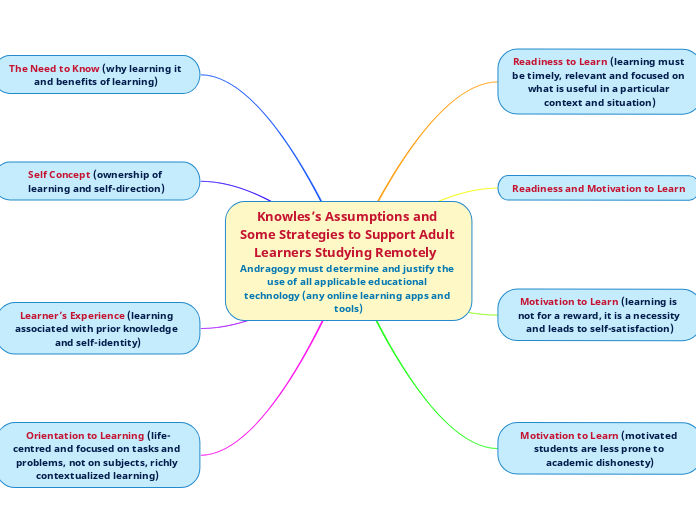Knowles’s Assumptions and Some Strategies to Support Adult Learners Studying Remotely Andragogy must determine and justify the use of all applicable educational technology (any online learning apps and tools)
Readiness to Learn (learning must be timely, relevant and focused on what is useful in a particular context and situation)
Establish clear learning goals and provide students with the directions on what exactly they should do, explicit success criteria (checklists, rating tools or rubrics with clear expectations), and student exemplars illustrating various levels of achievement. Respect students’ time: course content must address the curriculum requirements with maximized efficiency and be focused on what is relevant for the students. Students should not experience information and resource overload.
Readiness and Motivation to Learn
Offer Assistive technology to every student at the beginning of the course (for example, text-readers, closed captions, speech-to-text tools, language interpreter tools and subject-specific glossaries for ESL students).
Provide students with necessary tutorials (short videos) on navigating LMS and using required technology and tools.
Motivation to Learn (learning is not for a reward, it is a necessity and leads to self-satisfaction)
Provide students with various diagnostics and formative assessments and ongoing, timely, specific, descriptive, effective (and understandable by the learner) teacher feedback.
Invite and educate students to provide feedback to other students.
Diagnostics and practice assignments should welcome students to make their own mistakes.
Assessment grading and success criteria must address the curriculum expectations and yet be personalized and offer students multiple opportunities for content revisit and further improvement of their academic standing.
Motivation to Learn (motivated students are less prone to academic dishonesty)
Educate students on academic integrity expectations and the consequences of academic dishonesty.
Design plagiarism/cheat-proof summative assessments (it implies ongoing teacher-student communication, frequent checkpoints, mid-step interviews, teacher feedback and student reflection on such feedback, and student’s incorporation of teacher suggestions).
The Need to Know (why learning it and benefits of learning)
Encourage student’s goal setting, self-assessment based on daily practice, student’s self-reflection on their challenges and learning progress, and teacher and peer feedback.
Self Concept (ownership of learning and self-direction)
Utilize UDL and DI to address different learning styles and needs and provide various opportunities and choices for students to approach and demonstrate their learning.
Allow flexible timing/assignment deadlines for self-paced and self-directed learning within each unit.
Learner’s Experience (learning associated with prior knowledge and self-identity)
Offer students opportunities and choices to use their prior knowledge and skills and celebrate their cultural, racial and ethnic background through collaborative learning.
Students should be able to express their opinion and contextualize their learning.
Utilize Discussions forum, small-group work and virtual project fairs via FlipGrid or shared video, slide or audio presentations.
Orientation to Learning (life-centred and focused on tasks and problems, not on subjects, richly contextualized learning)
Deliver content through rich, open-ended, performance-, inquiry-, project- and problem-based, contextualized engaging tasks and activities.
